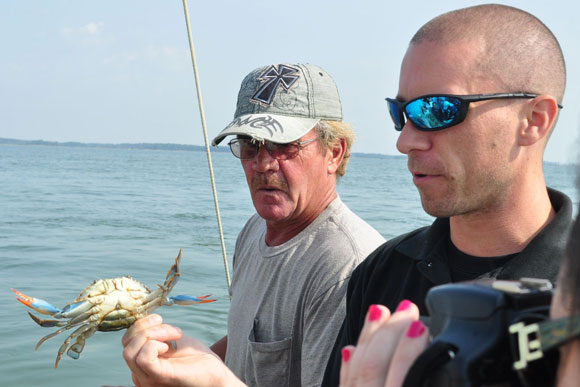A waterman on a boat in the Chesapeake Bay lifts a female blue crab into the air, its legs and claws flailing, and John Snedden is mesmerized. The owner and cook behind Rocklands Barbeque and Grilling Co., with four locations in and around D.C., is relishing the opportunity to see the region's signature seafood in its natural habitat.
Ben Parks — the second in a line of three family fishermen by the same name — shows him the "red fingernails" that distinguish the female's claws, the Capitol Dome-like shape on her belly, and the slight rust color that means she's nearing maturity. That rust color, he tells Snedden, means the crab is full of fat — and flavor.
"I like that," Snedden says, grinning. "That's good intel."

That intel is just one of the morsels Snedden picked up during a trip on the Chesapeake Bay with a handful of other chefs in the fall of 2012. Hosted by Steve Vilnit, director of fisheries marketing for Maryland's Department of Natural Resources, the boat trip helps connect D.C. chefs to the source of their seafood — the 5,500 commercial watermen operating in the bay. The outings add faces and flavors to the chefs' buying decisions, encouraging them to support the watermen they've met while sharing the story of the Bay with customers.
Snedden first met Vilnit when he worked for the seafood distributor J.J.McDonnell, selling products from across the world to district restaurants. Now he goes to Vilnit to learn about the best — and most sustainable — seafood being harvested in D.C.'s backyard pond, so to speak.
"After many years of living in the area, you travel and you realize what a great resource this is," Snedden says, gesturing to the water as the charter boat motored through the bay.
Vilnit has taken some 300 chefs out on the water in the summer of 2012 alone, demonstrating the difference between a trot line and a crab pot, which gear types for fishing are sustainable and which are not. He explains why a lump crab cake made entirely of Maryland crab garners such a high price: each five-inch-wide crab provides just two forkfuls of meat.
The Bay's little known yellow perch, for example, used to earn a small fishery 80 cents a pound. Now that restaurateurs have caught wind of the versatile and cheap white fish, it nets up to $4 a pound.
Snedden says seeing the seafood harvested firsthand, and meeting the people who do it, helps him make decisions based on value and connections rather than just price.
Part of Vilnit's job is to encourage sustainable seafood eating by getting chefs and consumers to think outside the crab-and-oysters box. Seventy-seven species of seafood are commercially harvested in Maryland. Some of the lesser known ones can be snagged for pennies a pound--that is, until Vilnit gets to promoting them.
The Bay's little known yellow perch, for example, used to earn a small fishery 80 cents a pound. Now that restaurateurs have caught wind of the versatile and cheap white fish, it nets up to $4 a pound.
And then there are the invasive species, like the snaggle-toothed snakehead, which fisheries are encouraged to harvest to promote the health of native species. Once the 800-plus chefs on Vilnit's email list were convinced of its edibility, items like "frankenfish tacos" started appearing on menus, driving up demand for the fish and pay for the fishermen.
Snedden used "intel" from the trip to source a wide variety of seafood for a weeklong dining event in October called From the Bay, For the Bay, with proceeds benefiting the Oyster Recovery Partnership. The partnership works with restaurants to recycle their used shells back into the Bay as habitat for oyster spat, among other projects
. Rocklands' menu featured rockfish, blue catfish, soft-shell crabs and even snakehead during the promotion.
"Certainly one of the things that's been reinforced from the trips is just what a phenomenal resource the Chesapeake is," he says.
"All this is a state away, and everybody wants local."
Also on the boat trip were chefs Joe Harran and Andrew Cleverdon who, after working for upscale eateries Vidalia and Bistro Bis, have opened a new D.C. restaurant called Woodward Table with a focus on regional food.
The two chefs, who both grew up in the area, have their sights set on incorporating into their menus the seafood Vilnit says is available right here — even turtle meat. Harran has in mind a turtle soup with cherry cream sauce and Old Bay spice.
"All this is a state away, and everybody wants local," Harran says.